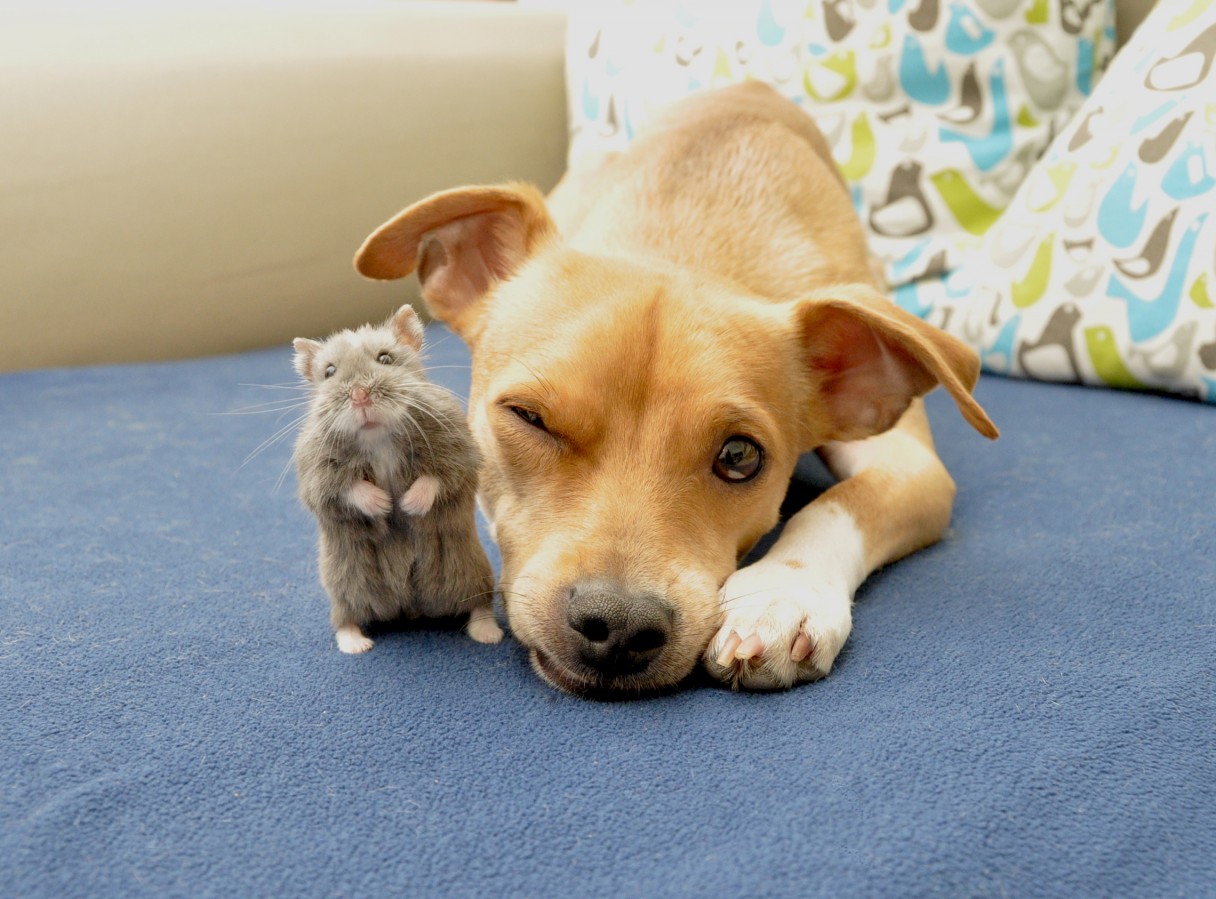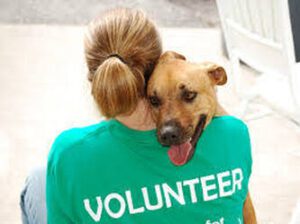Key Takeaways
-
Understand your hound’s natural instincts and work with them to prevent predatory behavior towards your hamster.
-
Create a safe and secure space for your hamster that’s out of reach from your hound, using a sturdy cage and strategic placement.
-
Introduce your hound and hamster by scent before visual contact to start building familiarity in a controlled manner.
-
Use positive reinforcement training to teach your hound appropriate behaviors around your hamster.
-
Be vigilant for signs of stress or aggression, and always supervise interactions between your hound and hamster.
A Peaceful Pack: Coexistence Strategies for Your Hound and Hamster
Bringing a hamster into a home with a hound can be a challenging venture, but with patience and the right approach, it’s possible to create a peaceful environment for both. It’s essential to understand that dogs and hamsters are naturally predator and prey, so we must be thoughtful and deliberate in how we manage their relationship. Let’s dive into how we can train our hounds to coexist with hamsters safely.

“American Kennel Club” from www.akc.org and used with no modifications.
Understanding Interspecies Dynamics
The dynamic between a hound and a hamster is fundamentally influenced by their natural instincts. Hounds, being descendants of wolves, have an innate predatory drive. In contrast, hamsters are small prey animals that can easily trigger a dog’s chase instinct. Recognizing and respecting these natural tendencies is the first step towards fostering a safe environment for both pets.
Common Challenges and Safety Guidelines
The most common challenge in bringing a hound and hamster together is the dog’s potential to view the hamster as prey. This can lead to stress for the hamster and unsafe situations. Therefore, it’s crucial to establish safety guidelines such as never leaving them unsupervised together and ensuring the hamster’s cage is escape-proof and out of the hound’s reach.
Canine Characteristics: Why Your Hound’s Instincts Matter
Before you even begin the process of introduction, take time to observe your hound’s behavior. Is your dog easily excitable or generally calm? Does it have a high prey drive, or is it indifferent to small animals? Knowing your dog’s temperament and instinctual responses will guide your training approach.
For instance, a hound with a high prey drive will require more focused training to manage its impulses around a hamster. On the other hand, a more laid-back dog may need less intervention but should still be taught to respect the hamster’s space.
It’s also worth considering the breed of your hound. Some breeds have a stronger hunting instinct than others, which can make the training process more intensive. Regardless of breed, all dogs have the potential to learn and adapt their behaviors with consistent training.
Nature versus Nurture: Instinctual Predatory Drives
While we can’t change the innate nature of our pets, we can nurture them towards desired behaviors. Understanding your hound’s predatory drives doesn’t mean accepting that they’ll act on them. It means acknowledging the need for a structured training plan that redirects those instincts in a positive way.
Recognizing Your hound’s Body Language and Cues
Being able to read your hound’s body language is key to preventing unwanted behavior. Look for signs of heightened interest or agitation when your hound is near the hamster’s area, such as fixating, stiffening, or whining. These cues tell you that your hound is focused on the hamster and may need redirection or a break from the situation.
Creating a Safe Zone: Preparing Your Home for Hamsters and Hounds
Setting up your home to accommodate both your hound and your new hamster is a vital step in ensuring their coexistence. This involves creating a secure space for your hamster that your hound cannot access. It’s not just about preventing escape; it’s also about reducing stress for your hamster by providing a sanctuary.
Choose a room for your hamster’s cage that your hound doesn’t frequent, or set up barriers that prevent your dog from getting too close. The goal is to allow both animals to live comfortably, without constant fear or excitement from either party.
Designating a Hamster Haven: Cage Selection and Placement
When selecting a cage for your hamster, opt for one that’s sturdy and secure, with bars that are close enough to prevent your hound from sticking its nose or paws inside. The cage should also have a solid base to catch any bedding that might otherwise tempt your hound.
Placement is just as important. Keep the cage elevated on a stable surface, out of reach of your curious hound. This not only prevents any potential accidents but also helps your hamster feel safe, as they can observe their environment from a vantage point without feeling threatened.
Remember, creating a peaceful household with a hound and a hamster takes time and effort. But with these strategies in place, you’re well on your way to fostering a harmonious multi-species home. Stay tuned for more detailed training tips and techniques in the next sections.
The Sniff Introduction: Scent as the First Step
Before your hound and hamster ever lay eyes on each other, they should get acquainted by scent. This is a gentle way to start the introduction process because both animals rely heavily on their sense of smell to understand their environment. Begin by swapping their bedding or toys between them so they can investigate each other’s scent without the stress of a face-to-face meeting. This can pique their curiosity in a safe and controlled manner.
Training Time: Behavioral Tips for Your Hound
Training your hound to behave around your hamster is crucial for their coexistence. It’s about creating a set of expectations and boundaries for your dog that respects the safety and comfort of your hamster. Let’s explore some effective training methods.
Reward-based Methods to Encourage Good Behavior
Positive reinforcement is your best friend when it comes to training your hound. This means rewarding your dog for calm and non-aggressive behavior around the hamster’s cage. Rewards can be tasty treats, affection, or playtime – whatever motivates your hound the most. Over time, your dog will associate these positive outcomes with behaving appropriately around the hamster.
For example, if your hound sits quietly next to the hamster’s cage without showing signs of aggression, immediately give a treat and praise. Consistent reinforcement of this behavior will teach your dog that being calm and gentle around the hamster is rewarding.
Distance and Supervision: Keeping Watch Over Interactions
Even with scent introductions and positive reinforcement, it’s essential to maintain a safe distance between your hound and hamster during their initial interactions. Never allow your hound to have direct access to the hamster. Instead, keep your hamster in its cage and your dog on a leash or behind a barrier when they’re in the same room.
Always supervise these interactions. You need to be present to intervene if your hound shows too much interest or starts displaying predatory behavior. If you see signs of stress or aggression, calmly separate them and try again later.
Commands and Cues: Teaching Your hound to Respond Reliably
Teaching your hound basic commands like ‘sit’, ‘stay’, and ‘leave it’ is incredibly useful. These commands can help manage your dog’s behavior around your hamster. Consistent training sessions will help your hound understand what’s expected and respond reliably to your cues.
Start by practicing these commands away from the hamster to ensure your dog has mastered them. Once your hound is responding well, you can gradually introduce these commands while in the same room as the hamster, always rewarding your dog for compliance. For more guidance on this process, check out our article on socializing your new senior rescue dog.
Monitoring Moods: Stress Signals in Hamsters and Hounds
Understanding and recognizing stress signals in both your hound and hamster is vital for preventing negative encounters. Stress can manifest in different ways, so it’s important to be observant and responsive to the needs of both pets.
Signs of Stress in Hamsters: When to Intervene
Hamsters may show stress by freezing, attempting to hide, or even biting. If you notice these behaviors, it’s a clear sign that your hamster is not comfortable with the situation. You should immediately remove your hound from the room and give your hamster some time to calm down. Always prioritize the safety and well-being of both animals when deciding how to proceed with their interactions.
It’s also crucial to ensure your hamster has plenty of hiding places within its cage. These can be tunnels, houses, or even cardboard tubes. A hiding place gives your hamster a sense of security and can greatly reduce stress during the introduction process.
Calming an Excited hound: Techniques to Soothe Your Pet
If your hound becomes too excited or fixated on the hamster, you’ll need to redirect its attention. Calmly but firmly command your dog to ‘leave it’ or ‘sit’. If your hound complies, immediately reward the calm behavior. If the excitement continues, it may be time to end the session and try again later when your dog is more relaxed.
Remember, never scold or punish your hound for showing interest in the hamster – this can lead to confusion and fear. Instead, use these moments as training opportunities to reinforce the behaviors you want to see.
Harmony at Home: Ensuring Long-term Success
Establishing a peaceful multi-species household is an ongoing process that requires patience and consistency. Let’s talk about how to maintain the harmony between your hound and hamster over the long term.
Maintaining Separate Spaces: The Importance of Personal Territory
It’s crucial for both your hound and hamster to have their own spaces where they can retreat and feel secure. For your hound, this might be a crate or a specific area of the house. For your hamster, it’s their cage, which should be a safe haven, free from the dog’s interference.
Respecting these separate spaces helps prevent stress and territorial behavior. It also gives both pets a sense of routine and stability, which is essential for their overall well-being.
With careful training, supervision, and a lot of love, your hound and hamster can live together in harmony. Remember to be patient, as this process can take time, but the reward of a peaceful, multi-species home is well worth the effort.
Routine and consistency are the backbone of any training process, especially when it involves multiple species. Your hound thrives on knowing what to expect, and your hamster needs a predictable environment to feel secure. By establishing a routine that includes regular training sessions, feeding times, and playtimes, you create a structure that both pets can rely on.
Stick to a schedule as much as possible. Feed your hamster at the same time every day, and keep your hound’s walk and meal times consistent too. This helps reduce anxiety for both animals because they know what to expect and when to expect it.
And remember, the key to maintaining this harmony is to never become complacent. Even if your hound and hamster seem to be getting along well, always supervise their interactions and be prepared to step in if needed. That’s how you ensure a balanced household for the long haul.
Routine and Consistency: The Key to a Balanced Household
For example, if you usually feed your hamster in the evening, make sure your hound is engaged in a separate activity at that time, like enjoying a chew toy or taking a walk with another family member. This prevents your hound from fixating on the hamster during a vulnerable moment.
Now, let’s address some common questions that may arise when training your hound to coexist with a hamster.
FAQs
When introducing a hound to a hamster, it’s natural to have a lot of questions. Here are some of the most common concerns addressed with straightforward answers to help you navigate the process smoothly.
Remember, every hound and hamster duo is unique, and what works for one pair may not work for another. Always tailor your approach to the specific needs and personalities of your pets.
With these FAQs, you’ll be better equipped to handle the challenges that come with training your hound to live harmoniously with a hamster.
How can I tell if my hound is too aggressive towards my hamster?
Aggression can manifest in various ways, such as growling, barking, or lunging towards the hamster’s cage. If your hound is displaying any of these behaviors, it’s a sign that they see the hamster as prey, and you need to intervene. Immediate redirection and further training are required to manage these aggressive tendencies.
Can hamsters ever roam freely if a hound is present?
It’s not recommended to let your hamster roam freely if there’s a hound in the house, even with training. The risk is too high, and it only takes a moment for instincts to take over. Always keep your hamster within a secure enclosure or playpen, and only allow them out when the hound is not in the room.
Even the most well-trained hound can have moments of unpredictability, so it’s better to err on the side of caution for the safety of your hamster.
What should I do if my hound seems obsessed with my hamster’s cage?
If your hound is fixated on the hamster’s cage, try to redirect their focus with training exercises or play. You can also move the cage to a height or room where your hound can’t see it. If the obsession continues, consider seeking the help of a professional trainer who has experience with multi-species households.
How can I trust my hound with my hamster while I’m not home?
Trust takes time to build, and even then, it’s best not to leave your hound and hamster unsupervised. If you must leave them alone, ensure the hamster’s cage is secure and placed in a room that your hound does not have access to. Taking these precautions minimizes the risks and keeps both pets safe.
Are certain hound breeds more prone to chase small animals?
Yes, some hound breeds have a higher prey drive due to their hunting heritage. Breeds like Greyhounds, Beagles, and Foxhounds are more likely to chase small animals. However, with proper training and socialization, even these breeds can learn to coexist peacefully with a hamster.


